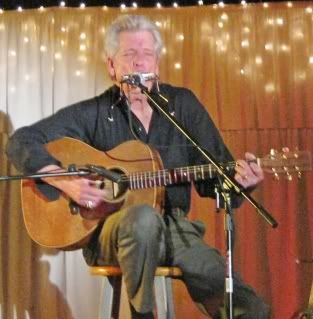
Veteran bluesman John Hammond entertained fans at
the Terrace Bay Inn on Feb. 25 during an event sponsored
by Blues for a Cause to benefit the Delta County Cancer
Alliance.
By STEVE SEYMOUR
John Hammond wove stories and songs into an intriguing personal history of his life in the blues during a Feb. 25 concert in the Upper Peninsula.
The bluesman played before 150 fans at Gladstone's Terrace Bay Inn at an event organized by Blues for a Cause, with proceeds benefiting the Delta County Cancer Alliance.
Working without a setlist, Hammond performed blues classics and original material dating from his self-titled 1962 debut album on Vanguard Records to "Rough & Tough," a 15-track compact disc released by Chesky Records in 2009.
Born in New York City, and raised by his mother after his parents split-up, Hammond discovered the blues in the late 1950s.
He tours extensively from his New Jersey base, and has worked to keep the songs of blues pioneers in the public consciousness.
With a catalog of more than three-dozen studio albums, Hammond told the crowd: "I've got a whole bunch of songs, so I'm just going to play what I feel like."
Armed with an acoustic guitar and harmonica, Hammond opened with "I'm Just Your Fool." The song was written by Little Walter Jacobs, widely regarded as the greatest harp player to emerge from Chicago in the postwar era and a great influence on Hammond.
Eyes clinched, Hammond seemed to channel the spirit of Jacobs, who died after a street fight in 1968 at the age of 37. 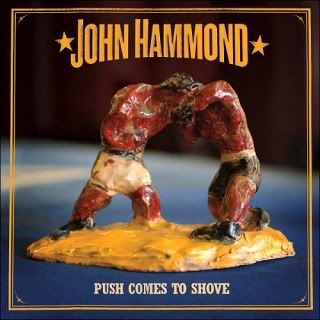
Next, Hammond turned to "Heartache Blues," a selection he wrote for the compact disc "Push Comes to Shove," issued in 2007.
"I got an ache in my heart, as sad as I can be," Hammond lamented, adding some mournful harmonica to the mix.
Hammond told the audience about being moved as a teenager by music he heard late at night on powerful Nashville radio station WLAC. Harking back to those years, he played "The Mean Old Lonesome Train."
The down-home country blues number was written by Lightnin' Slim, a master of Louisiana-style blues.
Finishing that song, Hammond switched to his National steel guitar, manufactured in 1935. "This was the loudest guitar you could buy before the electric guitar wiped it out," Hammond told the audience.
He then demonstrated his expertise on the instrument with "Walkin' Blues" and "Come On In My Kitchen."
Both songs were written by legendary Robert Johnson, who died on Aug. 16, 1938, apparently poisoned by a jealous husband. 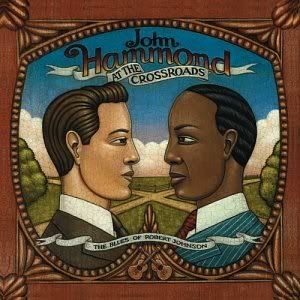
Hammond was so taken with the mythic figure that he recorded an entire album of Johnson material, including his two concert selections, for Vanguard Records in 2003.
Actually, Hammond discovered Johnson's music as a young man and taped "Crossroads Blues" for his eponymous first album.
In fact, Hammond's father, a talent scout and producer for Columbia Records, launched a futile attempt to sign Johnson for a "From Spiritual to Swing" concert at Carnegie Hall on Dec. 23, 1938, but the bluesman was already deceased.
Hammond returned with an original song, "You Know That's Cold," another track from the "Push Comes to Shove" CD.
Delving into the past, Hammond told the audience about picking-up an album of country blues on the Folkways label in 1957 and discovering such blues greats as Leroy Carr, Blind Boy Fuller and Blind Willie McTell.
Hammond played a medley of McTell songs, including "Love Changing Blues," in tribute.
Explaining he knew 400 songs early in his career, Hammond said he never felt the need to compose his own material. "A few years ago, my wife Marla said: 'Why don't you write a few songs for your next album? Maybe you could make some extra money.' Before you know it, I'd written eight songs."
Returning to his acoustic guitar, Hammond then performed one of them, "Come To Find Out," which was included on the 2005 CD "In Your Arms Again."
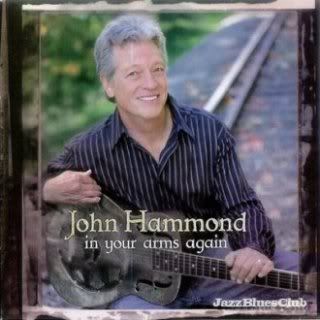
Recalling his early years as a student at Antioch College in Yellow Springs, Ohio, Hammond said he discovered "school wasn't the best place for me."
Consequently, he left for Chicago where he met Michael Bloomfield, one of the first white guitarists to make a mark in the blues. Bloomfield took Hammond to Maxwell Street, then a blues mecca, to see Sleepy John Estes and harmonica player Hammie Nixon perform.
Hammond supported the story with Estes' "Someday Baby Blues."
Continuing, Hammond recounted seeing Sonny Boy Williamson II, another great Windy City harp player, perform at Silvio's. Williamson didn't appear on stage with his band, but from a table, surrounded by three women. "I was mightily impressed," Hammond said, before playing Williamson's "Fattening Frogs For Snakes."
Saluting another legendary Chicago bluesman, Hammond performed a number by Jimmy Rogers, "That's Alright." Hammond, who played with many blues greats, recalled touring Canada with Rogers.
Now 67, Hammond followed with the first song he ever wrote, "Slick Crown Vic." The song is about the 1955 automobile he owned as a 19-year-old aspiring bluesman in Los Angeles.
Hammond recognized another influential blues figure with "One Kind Favor," by Blind Lemon Jefferson. Also known as "See That My Grave is Kept Clean," Hammond recorded the tune on his first LP and taped another version with the Blind Boys of Alabama years later.
Giving a tip of the hat to Big Joe Williams, Hammond played his National steel guitar for "Drop Down Mama." Hammond related that in exchange for driving him to gigs around Chicago, Williams let him play harmonica at the shows.
Hammond then revisited his most recent CD for "It Hurts Me Too," a track penned by Tampa Red, also known as Hudson Whittaker.
Next, Hammond played "I Wish You Would," by Chicago harpist Billy Boy Arnold. Hammond recorded the song for his 1976 album, "Solo."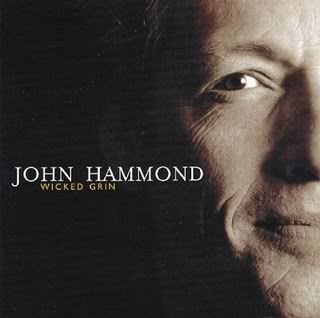
Hammond closed the show with "No One Can Forgive Me But My Baby," written by Tom Waits. The track is from the album "I've Got Love If You Want It." In 2001, Hammond released "Wicked Grin," an entire album of Waits' songs which proved to be a very successful collaboration.
With his expressive vocals, powerful, yet precise guitar-playing and evocative harmonica fills, Hammond commanded the audience's attention throughout the evening.
They rewarded him with a standing ovation.
After the concert, Hammond signed autographs and casually chatted with fans, showing why he's a tireless spokesman for the blues, on-stage and off.

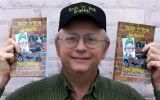
 I've enjoyed rock music and writing since I was a teenager in the 60s. I feel lucky to have been around when rock's greatest stars created their most enduring hits. At the same time I found I enjoyed writing, as well. I worked on my high school newspaper and magazine, was editor of several college publications and earned a bachelor's degree from Central Michigan University in 1973. I worked for the daily newspaper in my hometown after graduating, becoming managing editor after a few years. By the 1980s, I moved into public relations. In 1985, my wife Sue and I opened a retail music store, The Record Rack, which we still own. Rock 'n' roll has been integral to me and for the last 2O years I've been earning my living from it even though I don't have a musical bone in my body. In recent years, I've also I edited a small local magazine and launched a micro FM radio station. Now, I'm finally combining my love of writing and rock 'n' roll. I can't sing a note, but I know what I like. I'll tell you all about it when you read on. I hope you have as much enjoyment reading these installments as I've had writing them.
I've enjoyed rock music and writing since I was a teenager in the 60s. I feel lucky to have been around when rock's greatest stars created their most enduring hits. At the same time I found I enjoyed writing, as well. I worked on my high school newspaper and magazine, was editor of several college publications and earned a bachelor's degree from Central Michigan University in 1973. I worked for the daily newspaper in my hometown after graduating, becoming managing editor after a few years. By the 1980s, I moved into public relations. In 1985, my wife Sue and I opened a retail music store, The Record Rack, which we still own. Rock 'n' roll has been integral to me and for the last 2O years I've been earning my living from it even though I don't have a musical bone in my body. In recent years, I've also I edited a small local magazine and launched a micro FM radio station. Now, I'm finally combining my love of writing and rock 'n' roll. I can't sing a note, but I know what I like. I'll tell you all about it when you read on. I hope you have as much enjoyment reading these installments as I've had writing them.


No comments:
Post a Comment